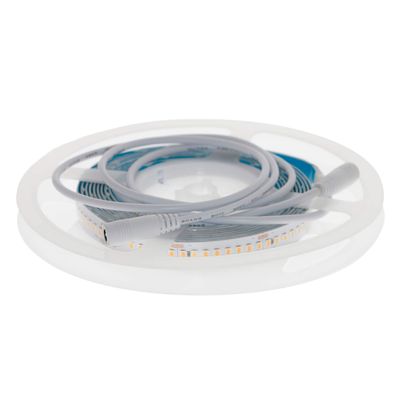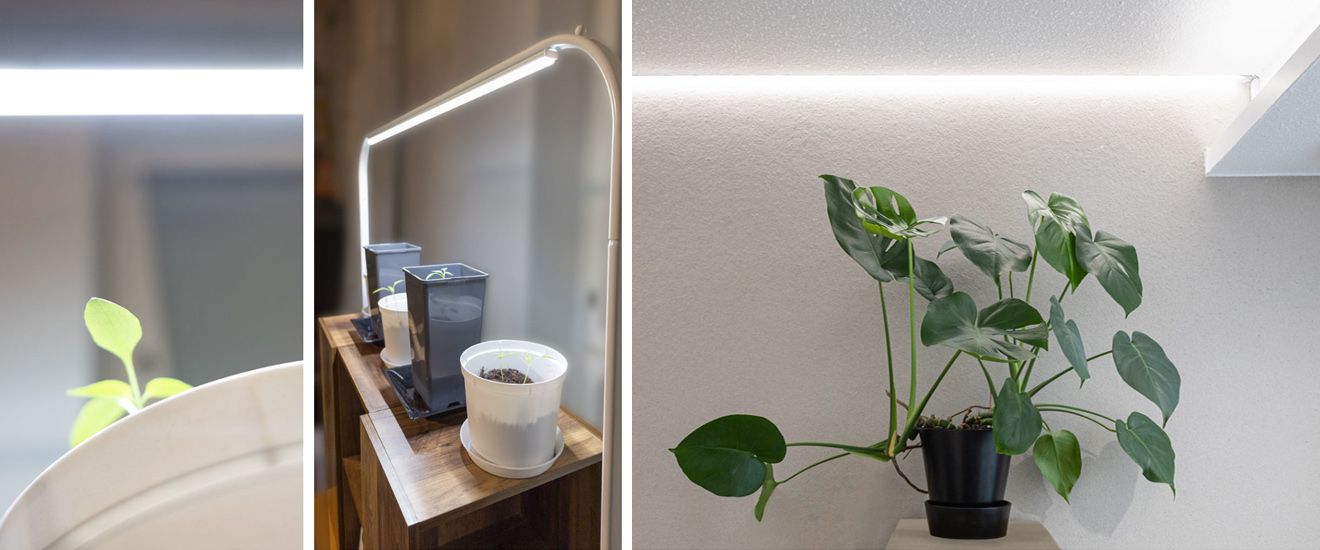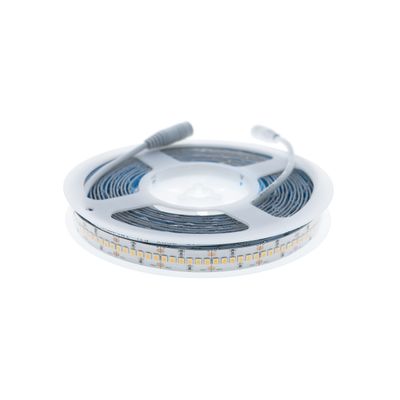Why are LED strip lights good for plants?
LED strip lights produce less heat than conventional lights
LED lights are energy efficient and environmentally friendly light sources that produce less heat than conventional lights. LED lights use electrical energy efficiently and convert it into light with little heat loss. Traditional lights, such as incandescent and halogen lamps, produce a lot of heat, which wastes energy and increases climate emissions. LED strip lights are also long-lasting and durable, reducing waste and saving costs.
LED strip lights consume less energy and last longer
LED strip lighting is an energy-efficient and long-lasting lighting solution for plants. They consume less energy and last longer than traditional incandescent or energy-saving light bulbs. LED lights also provide a uniform and pleasant light, the colour and brightness of which can be adjusted to suit your plants' needs.
LED strip lights are available in different shapes and sizes. For example, LED strip lights are flexible and easy to install on different surfaces such as walls, ceilings or furniture.
LED strip lights can be controlled either by traditional switches or by intelligent applications. Smart LED lights allow you to control lighting wirelessly, for example with your phone or tablet.
LED strip lights allow you to adjust the lighting of plants according to the different stages of growth
LED strip lights allow you to adjust the lighting of your plants according to their different growth stages. Our LED strip lights are energy-efficient, long-lasting and versatile light sources that can provide plants with an optimal light spectrum (CRI98!) for photosynthesis, growth and flowering. LED lights can be used with different colours of light that affect plant morphology, physiology and metabolism. For this reason, we recommend the use of LED strip lights, which can also be used to adjust the colour temperature (CCT)
However, the use of LEDs for plant lighting requires careful planning and selection, as different plants react differently to different wavelengths. For example, blue light promotes leaf growth and red light promotes flowering. Too much or too little of certain wavelengths can cause abnormal or stunted growth.
How to choose the right LED strip light for your plants?
Light colour affects photosynthesis and endocrine function in plants
Light colour affects plant photosynthesis and endocrine function in many ways. Plants use different wavelengths of light for different processes. For example, blue and red light promote photosynthesis, where plants produce sugar and oxygen.
Research shows that green light is reflected from the leaves of the plant and is therefore less effective for photosynthesis.
Another study found that yellow and orange light are also less useful for photosynthesis than blue and red light.
The colour of light also affects the endocrine activity of plants, which regulates their growth and development. Plants have special receptors that detect the wavelength and amount of light.
These receptors transmit signals to plant hormones that influence such things as shoot length, flowering timing and leaf drop. In particular, red and far-red light are important for detecting the length of a plant's day. Research shows that day length influences when plants start to flower or overwinter
The importance of light colour for plants is important to consider when growing in greenhouses or indoors, for example. The colour of light can influence how quickly and abundantly plants grow and produce crops. The colour of light can also be used to create different moods and visual effects in landscape design or garden art.
Light intensity affects plant growth and flowering
Light intensity is one of the most important factors affecting plant growth and flowering. Light regulates plant photosynthesis, the process by which plants convert light energy into sugar and oxygen.
Photosynthesis
Photosynthesis is the process of converting light energy into sugar and oxygen. Photosynthesis is the most important chemical reaction on Earth and a prerequisite for life. Photosynthesis is the main source of energy for plants and requires sufficient quantity and quality of light.
Quality of light
Light quality refers to the wavelength, or colour, of light. Plants particularly use blue and red light for photosynthesis.
Light quantity
Light quantity refers to the intensity or intensity of light and the duration of light, i.e. the length of the day.
Light intensity
The intensity of light affects the amount of photosynthesis that takes place and how fast plants grow. Too little or too much light can slow or prevent plant growth.
Light duration
The duration of light affects when plants start to flower. Some plants are short-day plants, meaning that they only flower when the day length is below a certain limit. Some plants are long-day plants, meaning that they only flower when the day length is above a certain limit.
Some plants are neutral, i.e. their flowering does not depend on the length of the day. The light requirements of plants vary depending on the species and variety.
It is important for the grower to know what kind of light is best for his plants and to adjust it if necessary.
The duration of light affects the resting and active periods of plants
As we said, the duration of light affects the resting and active periods of plants. Plants sense the quality, quantity, direction and duration of light and use it to guide their growth and development. Light is vital for plants because it enables photosynthesis.
In particular, plants need blue-violet, blue and red light, which affect plant size, colour, flavour, nutritional values and flowering. The colour temperature of light is expressed in Kelvin (K) and describes the colour tone of the light. Plants should be provided with an average of 1000 lux of light per day for about 10-12 hours. Lumens indicate the amount of light on the surface. Plant lighting can be used to increase the quantity and quality of light during the dark season and Led plant lighting increases the well-being of plants during the dark period.
There are different types of plant lights depending on the plants you want to grow. For example, plants that grow tall need a high-intensity light source to ensure that all leaves get enough light. Plant lights should be placed close to the plants, but not so close that they burn the leaves. Plant lights may not be the most attractive from an interior design point of view, but they are useful for plants and help them to stay healthy and vibrant.
How to install and use LED strip lighting for plants?
Choose a suitable location and mounting method for LED lights
When choosing a spot for LED lights, you should consider the light needs of the plants, the size and shape of the space, and the wattage and size of the lights. Generally, LED strip lights are placed above the plants to illuminate them evenly and effectively.
Choose the right type and colour of LED light for your plants
LED strip lights come in different types and colours, which affect plant growth and flowering in different ways. The most common types of LED strip lights are:
- Warm light is well suited for green plants and for general lighting indoors, e.g. for lighting plants on a green wall. The high colour rendering lamp has a warm white tint with some of the red that plants crave.
- Red-blue LED light: ideal for seedling and spot lighting for individual plants. The lamp combines red and blue LED bulbs to stimulate plant contact and flowering. The red/blue ratio can vary from lamp to lamp, but is usually 2:1 or 4:1.
- Full spectrum (CRI98-CRI100) LED strip: mimics sunlight as closely as possible and is suitable for all types of plants at all stages of growth. The lamp has all colours of light from red to violet. This is the best solution.
When choosing the colour of the LED light, you should think about what you want to achieve with your plants. If you want to speed up growth and flowering, a red-blue LED light is a good option. If you want to create a natural and pleasant atmosphere in your room, a warm-neutral LED light is a better choice. If you want to be sure that all plants and people will like it, choose a high colour rendering ribbon (CRI+95)
Measure the distance from the lights to the plants and adjust if necessary
One important factor in using LED lights is their distance from plants. Lights that are too close can burn or stress plants, while lights that are too far away do not provide enough light output. The right distance depends on the power of the LED lights, the type of plant and the stage of growth.
The distance of the lights from the plants depends on the power of the lights and the species of the plants. As a general rule, the more powerful the light, the further it can be from the plants.
Measure the distance from the lights to the plants and adjust if necessary. You can use a tape measure or ruler to measure. If the lights are too close, raise them up or move them further away from the plants. If the lights are too far away, lower them down or move them closer to the plants. Observe the plants' reaction to the lights and make further adjustments as necessary. Plants may show signs of stress, for example by wilting, yellowing or browning.
Set a timer to switch lights on and off
Plants also need dark time for rest and metabolism. It is therefore a good idea to set a timer to turn lights on and off to give plants the right amount of light per day.
The timer can be mechanical or digital. The mechanical timer is simple and inexpensive, but it is not very accurate and does not allow for different programming. A digital timer is more accurate and versatile, but requires electricity to work.
Setting the timer depends on the species of plant and the stage of growth. In general, green plants thrive on 12-14 hours of light per day, while flowering and fruiting plants need 16-18 hours of light per day.
When setting the timer, you should also take into account the amount of natural light and the time of year. In winter, it may be necessary to increase the amount of artificial light, while in summer it may be necessary to reduce it or to delay it until the evening or morning.
Use of LED strip lighting for year-round planting
LED strip lighting can be used to create optimal conditions for different plant species
LED strip lights can be used to create optimal conditions for different plant species by adjusting the colour, intensity and duration of the light. LED lights are also energy-efficient and long-lasting, reducing electricity consumption and environmental impact. LED lights are particularly suitable for indoor plant cultivation, such as hydroponics or aeroponics.
LED lights can simulate natural light or create different light spectra that influence plant growth, flowering and metabolism. LED lights therefore allow for tailored lighting of plants to improve their health and productivity.



